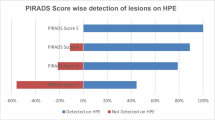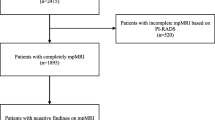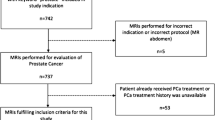Abstract
Purpose
To evaluate the diagnostic and staging ability of multiparametric MRI (mpMRI) compared to radical prostatectomy (RP) specimens after dissemination of this technology to several centres. mpMRI is an evolving technique aiming to improve upon the diagnostic sensitivity of prostate biopsy for the diagnosis of prostate cancer. Differences in interpretation, expertise and application of mpMRI are responsible for the range of reported results.
Methods
This retrospective clinical study was conducted with consecutive patients through an electronic database of tertiary hospitals and adjacent private urology practices in Australia. Patients having undergone RP were assessed for the presence of a pre-operative mpMRI performed between 2013 and 2015 which was evaluated against the reference standard of the RP whole-mount specimen. MRI reports were evaluated using the Prostate Imaging Reporting and Data System (PI-RADS).
Results
In our cohort of 152 patients, the sensitivity and specificity of mpMRI (PI-RADS ≥ 4) for prostate cancer (Gleason ≥ 4 + 3) detection were 83 and 47%, respectively. For the identification of extraprostatic disease, the sensitivity and specificity were 29 and 94%, respectively.
Conclusion
These results represent a ‘real-world’ approach to mpMRI and appear comparable to other single-centre studies. MRI staging information should be interpreted in context with other risk factors for extraprostatic disease. mpMRI has a useful role as an adjunct for prostate cancer diagnosis and directing management towards improving patient outcomes.

Similar content being viewed by others
References
Australian Institute of Health and Welfare (2014) Cancer in Australia: an overview 2014. AIHW Cancer Series, Canberra
Grummet JP, Weerakoon M, Huang S, Lawrentschuk N, Frydenberg M, Moon DA et al (2014) Sepsis and ‘superbugs’: Should we favour the transperineal over the transrectal approach for prostate biopsy? BJU Int 114(3):384–388
Chang DTS, Challacombe B, Lawrentschuk N (2013) Transperineal biopsy of the prostate—Is this the future? Nat rev Urol 10(12):690–702
Toner L, Weerakoon M, Bolton DM, Ryan A, Katelaris N, Lawrentschuk N (2015) Magnetic resonance imaging for prostate cancer—comparative studies including radical prostatectomy specimens and template transperineal biopsy. Prostate Int 3(1):107
Katelaris N, Bolton D, Weerakoon M, Toner L, Katelaris P, Lawrentschuk N (2015) Current role of multiparametric magnetic resonance imaging in the management of prostate cancer. Korean J Urol 56(5):337–345
Thompson J, Lawrentschuk N, Frydenberg M, Thompson L, Stricker P (2013) The role of magnetic resonance imaging in the diagnosis and management of prostate cancer. BJU Int 112(Suppl 2):6–20
Weinreb JC, Blume JD, Coakley FV, Wheeler TM, Cormack JB, Sotto CK et al (2009) Prostate cancer: sextant localization at MR imaging and MR spectroscopic imaging before prostatectomy-results of ACRIN prospective multi-institutional clinicopathologic study. Radiology 251(1):p122–p133
Johnston R, Wong L-M, Warren A, Shah N, Neal D (2013) The role of 1.5 Tesla magnetic resonance imaging in staging prostate cancer. ANZ J Surg 83(4):234–238
Barentsz J, Richenberg J, Clements R, Choyke P, Verma S, Villeirs G et al (2012) ESUR prostate MR guidelines 2012. Eur Radiol 22(4):746–757
Hamoen EHJ, de Rooij M, Witjes JA, Barentsz J, Rovers M (2015) Use of the prostate imaging reporting and data system (PI-RADS) for prostate cancer detection with multiparametric magnetic resonance imaging: a diagnostic meta-analysis. Eur Urol 67(6):1112–1121
de Rooij M, Hamoen EHJ, Witjes JA, Barentsz J, Rovers M (2016) Accuracy of magnetic resonance imaging for local staging of prostate cancer: a diagnostic meta-analysis. Eur Urol 70(2):233–245
Russo F, Regge D, Armando E, Giannini V, Vignati A, Mazzetti S et al (2016) Detection of prostate cancer index lesions with multiparametric magnetic resonance imaging (mp-MRI) using whole-mount histological sections as the reference standard. BJU Int 118(1):84–94
Greer M, Brown A, Shih J, Summers R, Marko J, Law Y, et al. (2016) Accuracy and agreement of PIRADSv2 for prostate cancer mpMRI: a multireader study. J Magn Reson Imag. doi:10.1002/jmri.25372
Junker D, Quentin M, Nagele U, Edlinger M, Richenberg J, Schaefer G, et al. (2014) Evaluation of the PI-RADS scoring system for mpMRI of the prostate: a whole-mount step-section analysis. World J Urol 33(7):1023–1030
Junker D, Schäfer G, Edlinger M, Kremser C, Bektic J, Horninger W, et al. (2013) Evaluation of the PI-RADS scoring system for classifying mpMRI findings in men with suspicion of prostate cancer. BioMed Res Int 2013:252939. doi:10.1155/2013/252939
Park S, Oh Y, Jung D, Cho N, Choi Y, Rha K et al (2016) Prediction of biochemical recurrence after radical prostatectomy with PI-RADS version 2 in prostate cancers: initial results. Eur Radiol 26(8):2502–2509
Pepe P, Garufi A, Priolo G, Pennisi M (2015) Can MRI/TRUS fusion targeted biopsy replace saturation prostate biopsy in the re-evaluation of men in active surveillance? World J Urol 34:1249
Osses D, van Asten J, Kieft G, Tijsterman J (2016) Prostate cancer detection rates of magnetic resonance imaging-guided prostate biopsy related to prostate imaging reporting and data system score. World J Urol. doi:10.1007/s00345-016-1874-7
Barrett T, Patterson A, Koo B, Wadhwa K, Warren A, Doble A et al (2016) Targeted transperineal biopsy of the prostate has limited additional benefit over background cores for larger MRI-identified tumors. World J Urol 34(4):501–508
Pokorny MR, de Rooij M, Duncan E, Schröder FH, Parkinson R, Barentsz JO et al (2014) Prospective study of diagnostic accuracy comparing prostate cancer detection by transrectal ultrasound-guided biopsy versus magnetic resonance (MR) imaging with subsequent MR-guided biopsy in men without previous prostate biopsies. Eur Urol 66(1):22–29
Toner L, Papa N, Aliyu S, Dev H, Lawrentschuk N, Al Hayek S (2015) Extended-spectrum beta-lactamase-producing Enterobacteriaceae in hospital urinary tract infections: incidence and antibiotic susceptibility profile over 9 years. World J Urol 7:1031–1037
Somford DM, Hamoen EH, Futterer JJ, van Basten JP, Hulsbergen-van de Kaa CA, Vreuls W et al (2013) The predictive value of endorectal 3 Tesla multiparametric magnetic resonance imaging for extraprostatic extension in patients with low, intermediate and high risk prostate cancer. J Urol 190(5):p1728–p1734
Gupta RT, Faridi KF, Singh AA, Passoni NM, Garcia-Reyes K, Madden JF et al (2014) Comparing 3-T multiparametric MRI and the Partin tables to predict organ-confined prostate cancer after radical prostatectomy. Urol Oncol 32:1292
Lawrence E, Gallagher F, Barrett T, Warren A, Priest A, Goldman D et al (2014) Preoperative 3-T diffusion-weighted MRI for the qualitative and quantitative assessment of extracapsular extension in patients with intermediate- or high-risk prostate cancer. AJR Am J Roentgenol 203(3):W280–W286
Renard-Penna R, Roupret M, Comperat E, Ayed A, Coudert M, Mozer P et al (2013) Accuracy of high resolution (1.5 tesla) pelvic phased array magnetic resonance imaging (MRI) in staging prostate cancer in candidates for radical prostatectomy: results from a prospective study. Urol Oncol Semin Orig Investig 31(4):448–454
Ahmed HU, Emberton M (2009) The role of magnetic resonance imaging in targeting prostate cancer in patients with previous negative biopsies and elevated prostate-specific antigen levels. BJU Int 104(2):269–270
Delongchamps NB, Rouanne M, Flam T, Beuvon F, Liberatore M, Zerbib M et al (2011) Multiparametric magnetic resonance imaging for the detection and localization of prostate cancer: combination of T2-weighted, dynamic contrast-enhanced and diffusion-weighted imaging. BJU Int 107(9):1411–1418
Vaché T, Bratan F, Mège-Lechevallier F, Roche S, Rabilloud M, Rouvière O (2014) Characterization of prostate lesions as benign or malignant at multiparametric MR imaging: comparison of three scoring systems in patients treated with radical prostatectomy. Radiology 272(2):446–455
Gaziev G, Wadhwa K, Barrett T, Koo B, Gallagher F, Serrao E et al (2014) Defining the learning curve for multi-parametric MRI of the prostate using MRI-TRUS fusion guided transperineal prostate biopsies as a validation tool. BJU Int 117:80
Acknowledgements
The authors would like to acknowledge the assistance of Dr Colin Styles MBBS FRANZCR and Dr Peter Smith MBBS FRANZCR from the University of Melbourne department of radiology.
Authors’ contributions
LT was involved in data collection and data analysis and wrote the manuscript. NP was involved in data analysis and edited the manuscript. MP edited the manuscript and was involved in manuscript revisions and data processing. NK was involved in data collection. MW was involved in protocol/project management and edited the manuscript. KC was involved in data collection. LH was involved in data collection. DMB was involved in protocol/project management and data collection and edited the manuscript. NL was involved in protocol/project management and data collection and edited the manuscript.
Author information
Authors and Affiliations
Corresponding author
Ethics declarations
Conflict of interest
The authors declare that they have no conflict of interest. This research was performed in the spare time of all authors without any financial support.
Ethical approval
Ethics approval was obtained from our institution’s ethical review board (LNR/15/Austin/234).
Informed consent
Informed consent was not required as it was a de-identified retrospective analysis.
Rights and permissions
About this article
Cite this article
Toner, L., Papa, N., Perera, M. et al. Multiparametric magnetic resonance imaging for prostate cancer—a comparative study including radical prostatectomy specimens. World J Urol 35, 935–941 (2017). https://doi.org/10.1007/s00345-016-1960-x
Received:
Accepted:
Published:
Issue Date:
DOI: https://doi.org/10.1007/s00345-016-1960-x




